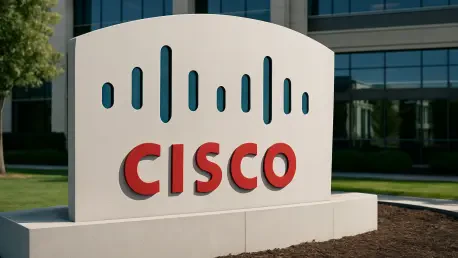I’m thrilled to sit down with Matilda Bailey, a renowned networking specialist whose expertise in cellular, wireless, and next-gen solutions has made her a trusted voice in the tech industry. With a keen eye on emerging trends and a deep understanding of market dynamics, Matilda offers unparalleled insights into Cisco’s latest developments. In this interview, we dive into Cisco’s recent earnings performance, the transformative growth in their security business, the booming AI infrastructure sector, and the impact of agentic AI on campus networks. We also explore strategic moves like the Splunk acquisition and the challenges posed by tariff uncertainties. Let’s get started.
How do you see the key factors that led to Cisco’s strong fourth-quarter performance, especially in surpassing revenue and EPS expectations?
Cisco’s Q4 performance was a standout, and I think several factors played a role in exceeding those expectations. First, their diversified portfolio across networking, security, and AI infrastructure has started to pay off, showing resilience even in a competitive market. The $14.67 billion in revenue reflects strong demand for their core networking solutions, bolstered by strategic product launches at Cisco Live. Additionally, their focus on operational efficiency likely contributed to the non-GAAP EPS of $0.99, which beat forecasts. I also believe their ability to guide above consensus for the next quarter signals confidence in sustained demand, particularly in high-growth areas like AI and security.
What’s your take on investor sentiment toward Cisco right now, given the stock’s 20% year-to-date gain despite a flat response in after-hours trading?
The 20% year-to-date gain shows that investors are recognizing Cisco’s long-term value and its pivot toward high-growth areas like AI infrastructure and security. However, the flat after-hours trading post-earnings suggests a bit of caution or profit-taking. Investors might be waiting for more concrete evidence of sustained double-digit growth in areas like security or clearer resolution on external risks like tariffs. Overall, I think sentiment remains cautiously optimistic—there’s appreciation for Cisco’s steady progress, but the market is looking for that next big catalyst to push the stock further.
Why do you think this quarter was labeled as one of the most important for Cisco in recent years, especially with the Cisco Live product announcements?
This quarter stood out because it was a critical proof point for Cisco’s strategic direction. The Cisco Live event showcased an unprecedented number of new products, from Smart Switches to advanced security solutions like Hypershield. These launches weren’t just about new tech—they signaled Cisco’s intent to lead in integrated, platform-driven solutions. The Q4 earnings validated that these innovations are resonating with customers, setting a foundation for fiscal 2026. It’s a pivotal moment as Cisco transitions from a traditional networking giant to a broader tech platform, and this quarter showed they’re on the right track.
Cisco’s security business grew by 9% year-over-year, which seems modest compared to peers. Can you unpack why this figure might not tell the whole story?
Absolutely, the 9% growth figure for Cisco’s security business, which hit $1.952 billion, can be deceptive at first glance. The key lies in the composition of their portfolio. Cisco has a mix of legacy security products that are being deprioritized and newer, high-growth offerings like XDR and SSE. The older products drag down the overall growth rate, but when you isolate the newer solutions, you see a much healthier 20% growth. Plus, if you exclude a challenging US Federal segment, the rest of the business actually grew at double digits. So, this 9% masks the real momentum in Cisco’s modern security offerings.
Speaking of those newer security products, what’s fueling the 20% growth in solutions like XDR and SSE?
The 20% growth in newer security products like XDR and SSE comes down to market demand and Cisco’s innovation. These solutions address critical needs in today’s threat landscape—XDR provides comprehensive threat detection and response, while SSE focuses on secure access in a cloud-first world. Cisco has tailored these products to integrate seamlessly with their broader networking ecosystem, which gives them an edge. Customers are also drawn to the scalability and the promise of future-proofing their security investments, especially as cyber threats become more sophisticated. It’s about meeting enterprises where they are and anticipating where they’re headed.
CEO Chuck Robbins highlighted 80 new Hypershield customers and over 480 new SSE customers this quarter. How significant are these adoption numbers for Cisco’s future in security?
These numbers are quite promising and signal strong early traction for Cisco’s security pivot. The 80 new Hypershield customers, tied to their innovative Smart Switch, show that Cisco is carving out a niche in integrating security with hardware—a unique value proposition. The 480 new SSE customers reflect the urgent need for secure, cloud-based access solutions as remote work and hybrid environments persist. While these figures are just a start, they indicate that Cisco is building a solid customer base in these high-growth areas, which could drive recurring revenue and deeper ecosystem lock-in over time.
With legacy security products shrinking in focus, do you anticipate Cisco achieving consistent double-digit growth in this segment soon?
I’m optimistic about Cisco reaching consistent double-digit growth in security, likely within the next few quarters. As the older, slower-growing products become a smaller portion of the portfolio, the higher growth rates of solutions like XDR, SSE, and Hypershield will dominate the numbers. Cisco’s leadership is clearly prioritizing investment in these areas, and with the market shifting toward integrated, cloud-native security, they’re well-positioned. If they continue to execute on customer adoption and innovation, I think double-digit growth will become the norm rather than the exception.
Cisco reported over $800 million in AI infrastructure orders in Q4, doubling their yearly projection to over $2 billion. What do you think enabled this remarkable growth?
Cisco’s AI infrastructure success, reaching over $800 million in Q4 orders, stems from a combination of strategic foresight and product excellence. Their Nexus switches, optics, AI PODs, and UCS servers have tapped into the explosive demand from webscale customers building out AI data centers. Doubling their yearly projection to over $2 billion shows how well they’ve anticipated this trend. Their focus on high-performance, scalable solutions has resonated with hyperscalers who need reliable infrastructure to support AI workloads. It’s a testament to Cisco’s ability to pivot into emerging markets with precision.
How has Silicon One contributed to Cisco’s traction with hyperscale customers?
Silicon One has been a game-changer for Cisco with hyperscale customers. This custom silicon offers market-leading price-to-performance ratios, which is critical for hyperscalers operating at massive scale where cost efficiency matters. Before Silicon One, Cisco had minimal presence in this segment, but this technology has allowed them to compete head-on with specialized vendors. It’s not just about the hardware—it’s about enabling hyperscalers to build AI and cloud infrastructure with flexibility and speed, which has cemented Cisco’s relevance in this fast-growing space.
Cisco’s partnership with Nvidia on the Spectrum-X product seems pivotal. How does this collaboration strengthen their position in the AI infrastructure market?
The partnership with Nvidia on Spectrum-X is a strategic win for Cisco. Being the only company with silicon integrated into Nvidia’s Spectrum-X product gives Cisco a unique edge in the AI infrastructure market. Nvidia’s dominance in GPUs for AI workloads means that Cisco can ride that wave, offering complementary networking solutions optimized for AI data centers. This collaboration not only boosts Cisco’s credibility but also positions them as a go-to partner for hyperscalers and enterprises building AI-ready infrastructure. It’s a powerful synergy that amplifies their market reach.
Looking beyond hyperscalers, how significant is the opportunity for Cisco to sell AI infrastructure to enterprises and sovereign cloud providers?
The opportunity for Cisco to sell AI infrastructure to non-hyperscalers like enterprises and sovereign cloud providers is massive and still largely untapped. As AI adoption spreads beyond tech giants, enterprises are looking to build AI-ready data centers, and sovereign cloud providers are prioritizing localized, secure infrastructure. Cisco’s Secure AI Factory blueprint, developed with Nvidia, is tailored for these markets. I think this segment could become a major growth driver in the second half of fiscal 2026, as these customers seek trusted vendors like Cisco to navigate the complexities of AI deployment.
Cisco noted that agentic AI will drive consistent, high network traffic. How do you see this impacting campus networks compared to current chatbot-driven traffic?
Agentic AI is set to transform campus networks in a big way. Unlike current chatbot interactions, which create sporadic traffic spikes, agentic AI will generate sustained, high levels of network activity due to constant agent interactions. This means campus networks, which are Cisco’s largest business unit, will need significant upgrades to handle the load. We’re talking higher-performing wired and wireless infrastructure to avoid bottlenecks. Additionally, as AI agents gain autonomous capabilities, the need for pervasive, integrated security becomes critical to ensure safe operations. It’s a dual challenge of capacity and protection that Cisco is gearing up to address with solutions like Smart Switches.
What’s your forecast for the impact of agentic AI on the broader networking industry over the next few years?
I believe agentic AI will be a defining force in the networking industry over the next three to five years. We’re likely to see a major refresh cycle for campus and enterprise networks as organizations upgrade to handle persistent, high-volume traffic. This will drive demand for advanced switching, routing, and wireless solutions, as well as integrated security to manage autonomous AI agents. Vendors like Cisco who can offer end-to-end, AI-optimized platforms will have a significant advantage. Beyond infrastructure, I expect agentic AI to push innovation in network management and automation, reshaping how networks are designed and operated to support an AI-driven future.









